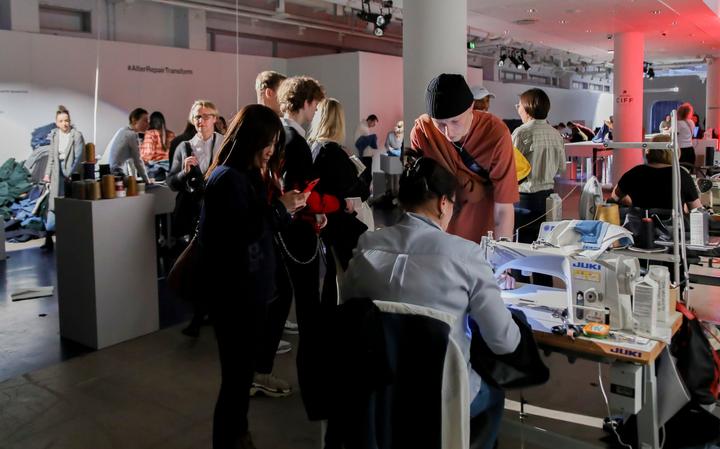How to wear jeans sustainably

The environmental impact of denim makes buying jeans problematic for eco-conscious shoppers. But more and more brands are developing innovative ways to lessen the damage
Why are jeans so controversial? Is it the estimated 10,000 litres of water needed to grow the cotton for every pair? The dark blue lines of toxic pollution in China’s Pearl River that can be seen from space? The potassium permanganate, widely used to make new jeans look old and distressed, that may cause lung damage in workers? Or is it because there is no guarantee that those workers are paid a living wage, never mind being paid for the overtime they are forced to do?
“The denim industry is at a pivotal moment,” says Roian Atwood, senior director of global sustainable business at Kontoor Brands, which owns Wrangler and Lee, when we met at ART (Alter Repair Transform), a denim upcycling and mending workshop at the Copenhagen international fashion fair (CIFF) last month. Lee are among the 30 brands contributing to the Ellen MacArthur Foundation’s Jeans Redesign project, a new initiative governing all aspects of jean production from regeneratively farmed fibres to washing and finishing techniques – potassium permanganate, for example, is not allowed. Jeans must be made with rivets and hardware that can easily be removed after the jeans are no longer fit for purpose, allowing them to be recycled into something new. The first products bearing the Jeans Redesign logo will go on sale in the autumn.
The industry is working hard to make itself cleaner and more sustainable, investing in new technology such as the innovative dry foam to dye Lee’s Indigood jeans – the use of water is pretty much eliminated, as well as reducing energy and chemicals and hopefully ending the rivers of toxic blue effluent. Already in operation at three denim mills in Spain, Mexico and India, Lee is also launching “compostable” jeans this spring. “They will fully decompose,” says Atwood. “We believe it will take 200 days.”

There is still a long way to go. According to Atwood, there is “a new and emerging environmental issue we are not quite ready to talk about yet, which is that denim has become integrated with a lot of synthetics. The comfort and the stretch movement, athleisure and the omnipresence of the yoga pant have given rise to a lot more stretch in denim. It’s plastic,” he says. And as such, your skinny jeans are responsible for shedding microplastics.
Appropriately enough, we meet in the “confessional booth” designed for visitors to confess their fashion sins and record them for a podcast. “If we are confessing our sins, I am here to say I like to wear light jeans,” he says. “A dark pair of denim uses less water in the wash-down process.” The lighter the denim, the more washing processes it has been through and the more water it has used.
The designer Duran Lantink, who was commissioned to work with Lee’s deadstock to create a small collection of upcycled denim, wears jeans every day (he switches between two vintage pairs) but is aware of the issues. “I think that, by buying a pre-washed jean, it is ruin in reverse,” he says. “I don’t get that.”
Lantink is part of a growing band of designers who are not just concerned about the environmental impact of the industry but also its waste. Bethany Williams, who has perfected the art of unpicking and upcycling unwanted jeans, has grown a cult following. Brands such as E.L.V. Denim (short for East London Vintage), which is sold at a range of stockists including Net-a-Porter, are building healthy businesses using secondhand denim as their raw material. “There are more jeans than people in the world,” says founder Anna Foster. At her studio and showroom, clients can choose from off-the-peg or custom-made jeans, ingeniously spliced together a few miles away at the Blackhorse Lane Ateliers in Walthamstow.
But slowing down production is not on the agenda for the big denim brands, who would prefer to cut their environmental impact by reducing water and chemical consumption while continuing to produce at the same levels. However, there are some smart and potentially highly disruptive initiatives coming from smaller independents. Netherlands-based Mud Jeans offers a subscription system that allows you to lease your jeans for €7.50 per month, including free repairs. Once you are finished with your jeans, you send them back and they will be recycled. Hiut Jeans, which has revitalised the denim industry in Cardigan, Wales, makes just 100 pairs of jeans per week. “We are here to try and make the best jeans we can and not the most jeans we can,” it says. It also offer free repairs for life.